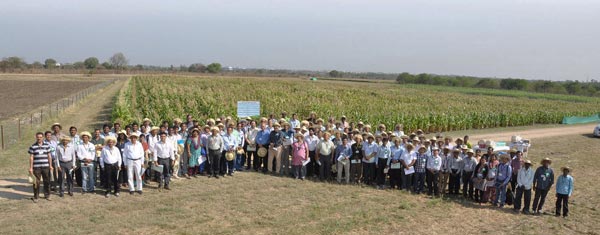By Kartikeya Krothapalli/CIMMYT
The International Maize Improvement Consortium-Asia (IMIC-Asia) held a maize field day on 15 March in conjunction with CIMMYT-Asia on the International Crops Research Institute for the Semi-Arid Tropics (ICRISAT) campus in Hyderabad, India.
The 900 germplasm entries on display included inbred lines of early and advanced generations along with some breeding populations and hybrids. This germplasm was bred for IMIC priority traits such as high seed yield, good standability, yellow and orange color, resistance to common foliar diseases and tolerance to drought and heat. Some promising hybrid combinations, along with their component inbred lines, were part of this demonstration. The field day was attended by IMIC partners from both the public and private sectors.

Swapan Datta, deputy director general of crop science for the Indian Council of Agricultural Research, was the chief guest. Other dignitaries included O.P. Yadav, director, Directorate of Maize Research; B.M. Prasanna, director, CIMMYT Global Maize Program; Etienne Duveiller, CIMMYT regional representative and director for South Asia; and Vibha Dhawan, deputy director of research partnership and coordination, Borlaug Institute for South Asia. After hearing a brief introduction to the demonstration by the CIMMYT team, including B.S. Vivek, P.H. Zaidi and A.R. Sadananda, participants spent the rest of the morning making selections.
Of the 90 participants, 55 were from private companies and 35 from public institutions. In total, 20 public institutions participating in the All India Coordinated Research Project on Maize and 31 private companies were represented. Participants also attended the IMIC-Asia general body meeting with discussions on a proposed centralized doubled haploid facility for Asia, public sector perspective on public-private partnerships (PPP), private sector outlook on maize in Asia, germplasm enhancement of maize (GEM —which is a model of germplasm enhancement, evaluation and exchange through PPP) and strengthening IMIC activities and functioning through multi-location testing, better trait prioritization and site selection. The meeting concluded with the election of a new steering committee.
 Capacity development
Capacity development